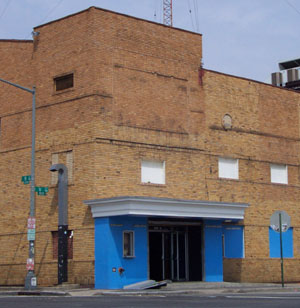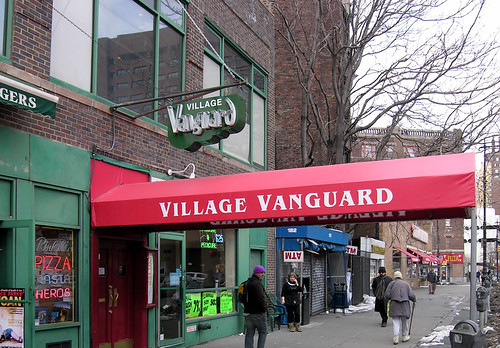There has been much recent chatter in the blogosphere on the declining audience for jazz. In the Wall Street Journal this weekend, Terry Teachout points out that in the process of becoming a self-conscious art music during the middle of the twentieth century, jazz music became no longer "capable of appealing to the same kind of mass audience that thrilled to the big bands of the swing era." Peter Hum investigated a number of approaches to expanding the jazz audience on Thursday, including hybridizing jazz with other musical forms (an approach which yielded mixed results during the 1970s), promoting younger artists more heavily, and getting John Scofield into the next guitar hero game (which I think would be a great idea regardless of the implications on the audience of jazz). At A Blog Supreme, Patrick Jarenwattananon notes that attendance at all "high-cultural activity" is down (likely due in part to the economic crisis), but is nonetheless troubled by the shrinking audience.
I think jazz musicians can take a lesson from alternative comedy in expanding the audience. In the wake of the comedy boom of the 1980s, a number of comedians like David Cross, Janeane Garafolo, and Patton Oswalt began looking for new venues for stand-up. The idea was to perform where their audience would already be, rather than pulling their fans into the already-established network of comedy clubs. As Nathan Rabin of the AV Club put it, "Fans of Comedians mainstays Patton Oswalt and Zack Galifianakis are more likely to check out an indie band at The Troubadour than shell out $40 to see a Tonight Show regular play Señor Ha Ha's Laughatarium." So why not follow your fans to their native setting?
While this movement initially grew out of Los Angeles, alternative comedy scenes also began to flourish in Seattle, New York, Chicago, and a number of other cities. What is important to remember, though, is that instead of altering their acts to make them more palatable to younger audiences, these comics simply brought there acts to venues where young people who would otherwise like their material would go to see a comedy show.
I do not know if the "answer" to jazz's audience question will be to move performances to indie rock clubs (though some performers, like The Bad Plus and Medeski Martin & Wood, already play a number of gigs each year at these kinds of venues), but I am certain that the current jazz club paradigm repels a good number of people from live jazz. The club itself is a good atmosphere for jazz; small and intimate, enabling a personal connection between artist and audience. But it is not everyone's ideal. This is not a new criticism. Jazz clubs are expensive (one night I saw Kenny Garrett in Miami at the now-defunct Arturo Sandoval's Jazz Cafe, and paid a $30 cover with a two-drink minimum on top of that - and those two drinks were not cheap). Compare that to an indie-rock venue, where you can see a good band for $20 (and the beer is cheaper).
 The 9:30 Club in Washington, DC, where you can see Son Volt, Mos Def, Janeane Garafolo, and The Bad Plus.
The 9:30 Club in Washington, DC, where you can see Son Volt, Mos Def, Janeane Garafolo, and The Bad Plus.Jazz clubs are also not mixed-use. Most people listen to a variety of genres, and are more likely to attend shows at the same venue if it offers an eclectic range of performances. Jazz clubs, while housing a diversity of jazz artists, largely stick to jazz, which may limit the marketing possibilities for jazz. The 9:30 Club in Washington, DC, hosts a variety of acts ranging from hip hop to indie rock to standup comedy, as well as numerous points in between. It would seem like an advantage for the club itself to draw from diverse fanbases, and that at least a small part of the audience from a Mos Def show might be interested in seeing a jazz act at the same venue if they saw some promotional material (posters, flyers, etc.) for that act while at the Mos Def show (I believe the marketing term for this is cross-promotion).
Maybe we won't see thousands of budding young jazz fans flowing out from mixed-use venues like these, but it certainly would not hurt to try and expand the live-music model, which is limited mostly to jazz clubs and summer festivals. Jazz musicians may not reap the same rewards that alternative comics found, but they cannot wait around for their audience to find them, they must seek them out personally.
UPDATE: Howard Mandel thinks Teachout doth protest too much, while Jason Parker is onto something.
Vanguard photo via Professor Bop's flickrstream, 9:30 Club photo via Excess Void.




3 comments:
Great post, David. And great minds think alike! http://bit.ly/No7vj
I couldn't agree more. I live and D.C. and saw both Janeane Garafalo and The Bad Plus at the 9:30. And these same thoughts and frustrations crossed my mind. Matt Haimovitz, acclaimed classical cellist played at Iota down the road in Arlington. I told him myself how utterly necessary it is for serious music to "take it to the streets". These venues are multi-use, affordable, informal, and approachable most importantly. College students aren't trying to hang at the Kennedy Center.
However, that's part of it. The other part is the music. Unlike the more static form of Haimovitz's classical genre, Jazz is a living breathing art form. The following quotes express my frustrations the best :
-
"One of the challenges in current Jazz is making studio records that break the mold of basic, what-you-hear-is-what-you-get, documentary style affairs. (Perhaps it's a potential challenge largely ignored.) European musicians are more up to this than Americans, and Gianluca Perella, a young, adept Italian trombonist, has just raised the bar a bit" Ben Ratliffe (N.Y. Times)
"Pop musicians compose with Timbre. Pitch and Harmony are becoming less important" Daniel Levitan (Music Scientist)
"So much of Jazz is far too undramatic ... Jazz is in an audience crisis and I blame the musicians for not taking the responsibility to deliver the goods" Ethan Iverson of The Bad Plus
-
Musicians dictate the future of music. Not critics. And to every tweedy Jazz snob that bemoaned Dave King as "too loud"? Fuck 'em. Either get on board or get, the fuck, out of the way. If new art isn't bothering some of the self appointed guardians at the gate - the establishment. Well then, it's not doing it's job. I for one was beside myself to hear 'Jazz with Genitals' for a change - finally, some ballllz. I think I speak for many younger musicians when I say that some of the things older fans bristle at we find second nature. We grew up on Nirvana and Hip-Hop. If you can't take fresh standards, timbre, sampling, or volume. Go listen to some of that stale "Hotel Jazz" that is making this genre the very boring joke it's become. These innovations do not make one any less of a player in the right hands. And those right hands - that manage innovation with technique, will be the future of Jazz development.
Just makes me sad that that such ideas need suggesting. It should be expected and only natural that for these things to happen. But I'm sure future generations won't bat an eyelash at venue, volume, or innovations in sampling and timbre.
1. Sign young(er) artists.
2. Take it to the streets. Play rock clubs, and multi-use venues. Go to where the college kids are - that demographic that Jazz thrived on in the 60's.
3. Accept change or get out of the way if you can't lend a hand. Wether it be venue, volume, timbre, rhythm or repertoire. I end up improvising with or arranging songs that I loved growing up. It's only natural to love that music, and so will our future audience. You can have your dusty "Misty". ( But I'll still keep Autumn Leaves and other great melodies, just not all ;-)
D.Caf
www.myspace.com/primrosehillmusic
http://www.youtube.com/user/DanMcCaffrey
Post a Comment